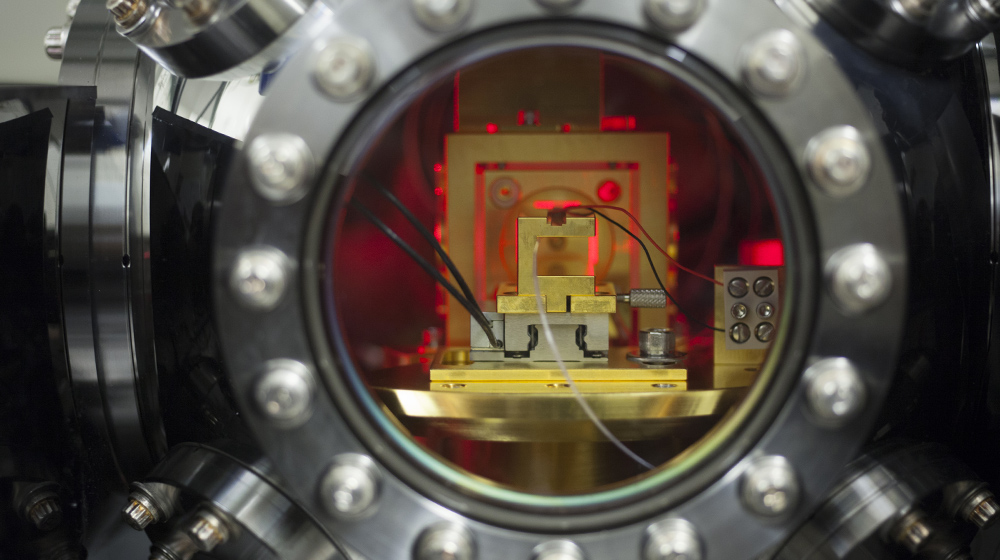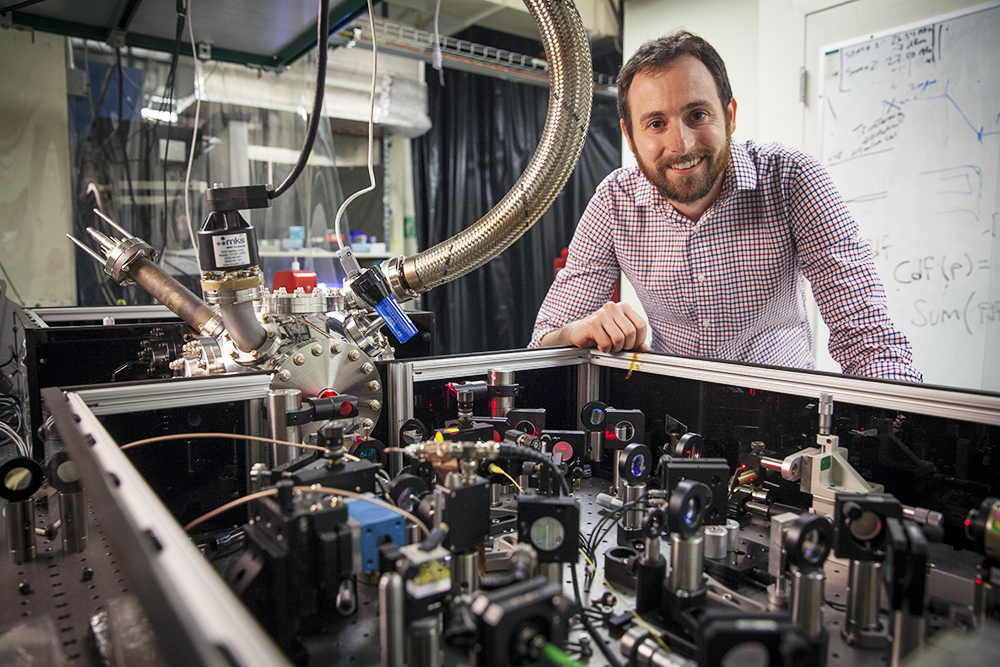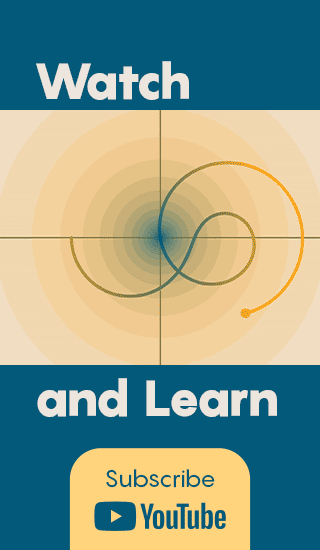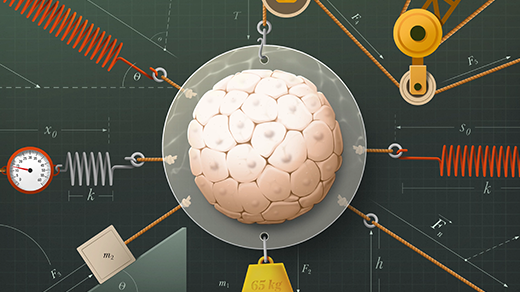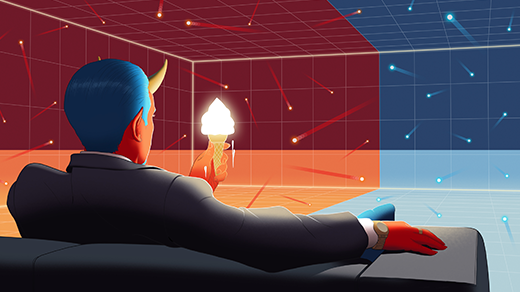Tiny Tests Seek the Universe’s Big Mysteries
Introduction
To answer some of the biggest unsolved questions in the cosmos, you might not need a supercollider. For decades, theorists have been dreaming up a Wild West of exotic physics that could be visible at scales just below the thickness of a dollar bill — provided you build a clever-enough experiment, one small enough to fit on a tabletop. Over distances of a few dozen microns — a little thinner than that dollar — known forces like gravity could get weird, or, even more exciting, previously unknown forces could pop up. Now a new generation of tabletop experiments is coming online to look into these phenomena.
One such experiment uses levitated spheres of silica — “basically a glass bead that we hold up using light,” according to Andrew Geraci, the lead investigator — to search for hidden forces far weaker than anything we can imagine. In a paper uploaded to the scientific preprint site arxiv.org in early March, his team announced that they had detected sensitivities of a few zeptonewtons — a level of force 21 orders of magnitude below a newton, which is about what is needed to depress a computer key.
“A bathroom scale might be able to tell your weight to maybe 0.1 newtons if it was very accurate,” said Geraci, a physicist at the University of Nevada, Reno. “If you had a single virus land on you, that would be about 10–19 newtons, so we’re about two orders of magnitude below that.”
The targets of these searches feature in some of the most compelling questions in physics, including those that center on the nature of gravity, dark matter and dark energy. “There’s a whole panoply of things these experiments could look for,” said Nima Arkani-Hamed, a physicist at the Institute for Advanced Study in Princeton, N.J. For example, dark matter, the massive stuff whose existence has been inferred only on astronomical scales, might leave faint electric charges behind when it interacts with ordinary particles. Dark energy, the pressure powering the accelerating expansion of the universe, might make itself felt through so-called “chameleon” particles that a tabletop experiment could theoretically be able to spot. And certain theories predict that gravity will be much weaker than expected at short range, while others predict that it will be stronger. If the extra dimensions posited by string theory exist, the tug of gravity between objects separated by a micron might exceed what Isaac Newton’s law predicts by a factor of 10 billion.
Janet Conrad, a physicist at the Massachusetts Institute of Technology who is not directly involved with any of these small-scale searches, thinks that they complement the work done at massive accelerators such as the Large Hadron Collider. “We are like dinosaurs. We have gotten bigger, and bigger, and bigger,” she said. But experiments like these offer the chance for a more agile kind of fundamental physics, in which individual researchers with small devices can make a big impact. “I really do believe that this is a new field,” she said.
For theorists like Arkani-Hamed, what happens just beyond the limits of our vision is interesting because of a curious numerical connection. The Planck scale, the infinitesimal size scale in which quantum gravity is thought to rule, is 16 orders of magnitude smaller than the weak scale, the neighborhood of particle physics explored in the Large Hadron Collider.
Theories that blend these length scales often compare the two. (Physicists will take the length of the weak scale, square it, then divide this number by the length of the Planck scale.) The result of the comparison yields a range of distances matching what may be another fundamental scale: one that runs between a micron and a millimeter. Here, Arkani-Hamed suspects, new forces and particles may arise.
Similar sizes arise when physicists consider the dark energy that fills empty space throughout the universe. When that energy density is associated with a length scale on which particles may be acting, it turns out to be about 100 microns — again suggesting this neighborhood would be an auspicious place to look for signs of new physics.
One such search started in the late 1990s, after Arkani-Hamed and two colleagues suggested that gravity may be leaking into extra dimensions of space, a process that would explain why gravity is far weaker than the other forces known to physics. At scales smaller than the extra dimensions, before gravity had a chance to leak away, its attraction would be stronger than expected. The researchers calculated that these dimensions could be as big as a millimeter in size.
This inspired Eric Adelberger and his colleagues to search for those dimensions. They already had the device to do it. In the 1980s, Adelberger and the so-called Eöt-Wash group at the University of Washington had built a device called a “torsion balance” that would twist in response to small forces. At first the group used the balance to search for a “fifth force” that had been proposed based on century-old experimental results. They failed to find it. “We built an apparatus, and we found that this thing wasn’t true,” Adelberger said. “It was so much fun, and it was much easier than we thought it would be.”
Now they set out to work on Arkani-Hamed’s prediction that gravity would be much stronger at small distances — before it has a chance to leak into extra dimensions — than when objects are farther away.
Since 2001, the team has published results from four torsion balances, each more sensitive than the last. So far, any diminutive dimensions haven’t revealed themselves. The team first reported that gravity acts normally at a distance of 218 microns. Then they reduced this number to 197 microns, then 56, and finally 42, as reported in a 2013 study. Today, their data come from two different instruments with pendulums. One pendulum twists at a rate determined by the strength of gravity; the other should stay still unless gravity behaves unexpectedly.
But they haven’t been able to shrink their measurements much beyond 42 microns. Currently, they’re tweaking the 2013 analysis, and they hope to publish updated numbers soon. While Adelberger is hesitant to cite the new limit they’re pushing for, he said it’s unlikely to be under 20 microns. “When you first do something, the bar is relatively low,” he said. “It gets so much harder when you make the distances shorter.”
Techniques borrowed from atomic physics may indicate another way down the ladder, even to nanoscopic scales.
In 2010, Geraci, then a physicist at the National Institute of Standards and Technology in Boulder, Colo., suggested a scheme to probe hidden forces at tiny scales. Instead of using the pendulums at Washington, small-force hunters could use spheres of silica levitated by lasers. By measuring how nearby objects change the position of a floating bead, this kind of experiment can look at the forces spanning just a few microns. Lucy Reading-Ikkanda for Quanta Magazine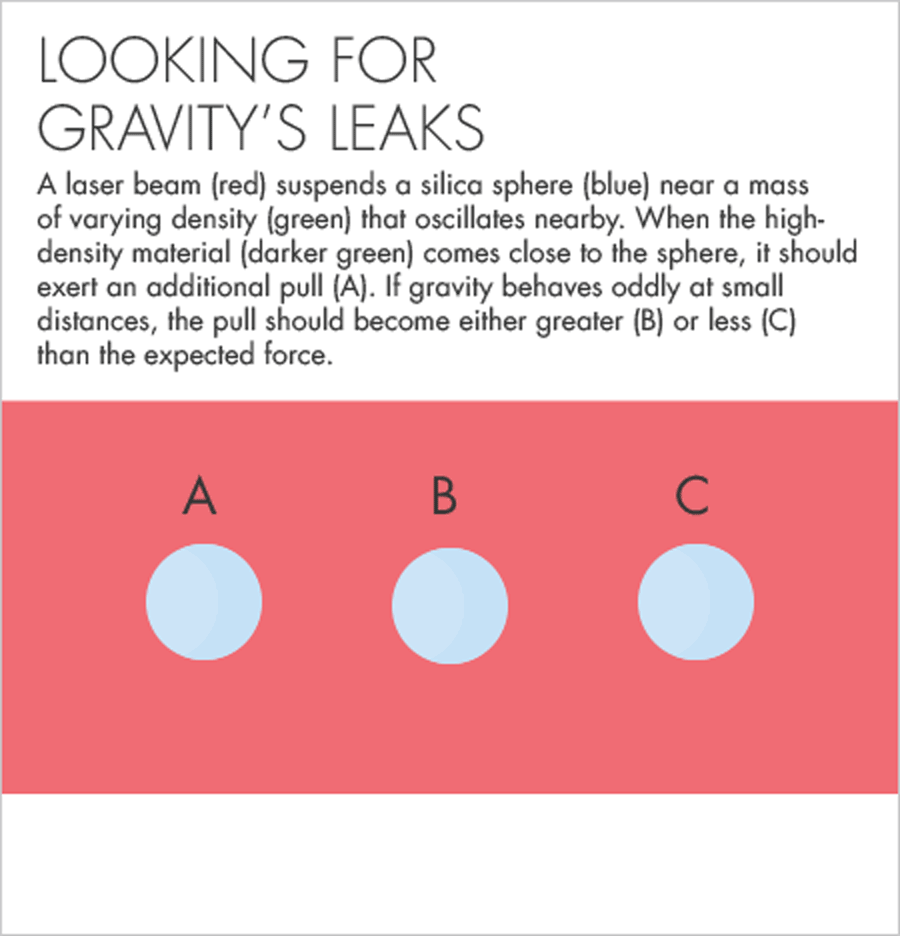
The experiment is able to probe scales of smaller lengths, but there’s a catch. Gravity is most easily measured using massive objects. Geraci’s design, now built, uses spheres just 0.3 microns in size. David Moore, a physicist at Stanford University who works in the lab of Giorgio Gratta, has his own working version that uses larger silica spheres about five microns in diameter. Compared to the Eöt-Wash team, which uses torsion balances that are a few centimeters wide, both experiments trade away the larger gravitational signals for more precision at close range.
Geraci’s and Moore’s masses are so light that the teams are not yet able to directly measure the gravitational pull of nearby objects; they can only see it if it turns out stronger than predicted by Newton’s law. That may make it harder to determine if gravity or something else is behind anything strange they might see. “One thing we always like to point out about gravity is that having the force sensitivity to see gravity is basically table stakes to play the game,” said Charlie Hagedorn, a postdoc at Washington. Adelberger adds, “If you want to know what gravity does, you’ve got to be able to see it.”
But to Geraci and Moore, the levitated beads are a general platform they can use to investigate small physics beyond just gravity. “The vision here is that once you’re able to measure these tiny forces, there’s a lot you can do,” Moore said. At the end of 2014, Moore conducted a search for particles with electric charges much smaller than one electron. Some models of dark matter suggest these “millicharged” particles could have formed in the early universe, and could still be lurking in ordinary matter.
To try to find these particles, Moore held positively charged spheres between a pair of electrodes. He then zapped the entire apparatus with flashes of ultraviolet light to knock electrons off the electrodes. These electrons then attached to the positively charged spheres, turning them neutral. Then he applied an electric field. If any millicharged particles were still stuck on the spheres, they would impart a small force. Moore didn’t see any effects, which means that any millicharged particles must have an exceedingly small charge, or the particles themselves must be rare, or both. Lucy Reading-Ikkanda for Quanta Magazine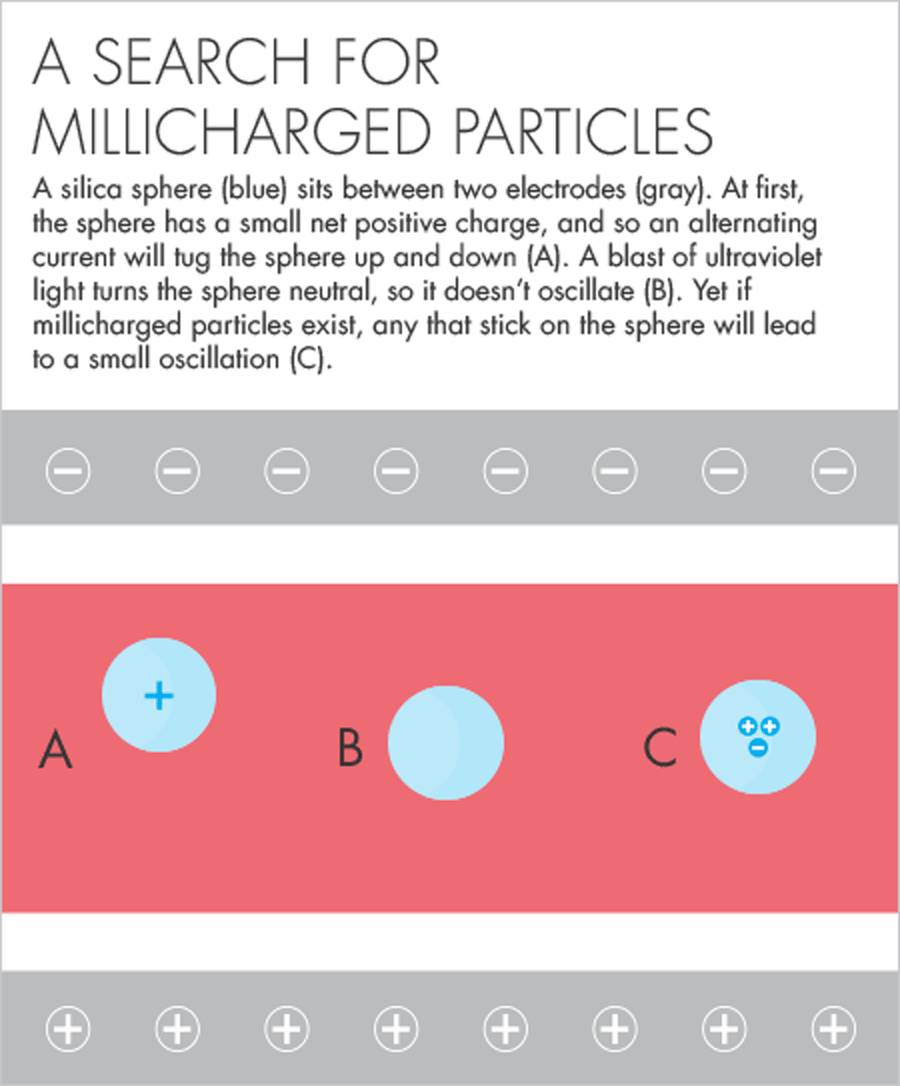
In a more recent test published in April, Moore, working with his colleagues Alex Rider and Charles Blakemore, also used the microspheres to look for so-called “chameleon” particles that may explain dark energy. They didn’t find any, a result that echoed one published last year in the journal Science by a team at the University of California, Berkeley.
“These small-scale experiments are — I don’t know what it’s called in English — ‘wild goose chase’?” said Savas Dimopoulos, a physicist at Stanford who was a co-author of the paper with Arkani-Hamed that proposed the search for millimeter-size extra dimensions. “You don’t really know where to look, but you look wherever you can.”
For Dimopoulos, these tabletop searches are an appealing cottage industry. They offer a cheap alternative way to study provocative theories. “These ideas have been proposed over the last 40 years, but they’ve been staying on the back burner, because the main focus of fundamental physics has been accelerators,” he said.
It’s a pitch Dimopoulos has been honing in talks over the last three years. Several experiments like those aimed at short-range forces are in the works, but they’re underfunded and underappreciated. “The field doesn’t even have a proper name,” he said.
What might help is what Dimopoulos calls a “super lab” — a facility that would bring many such tabletop experiments together under one roof, like the research communities that have built up around high-energy projects like the Large Hadron Collider. Conrad, for her part, would like these endeavors to be better supported while still remaining at universities.
Either way, both argue that more effort is warranted in the search for lower-energy particles, especially those predicted to lurk at scales only a little smaller than the width of a human hair. “There is a whole zoo of these things,” Dimopoulos said. “High energy is not the only frontier that exists.”
This article was reprinted on Wired.com.
